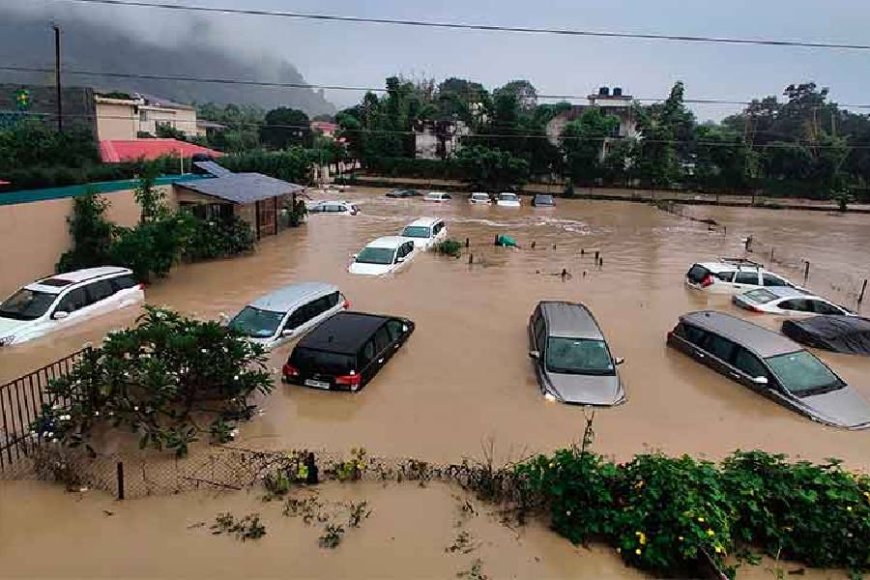Himachal Pradesh Devastated by Flash Floods: Climate Crisis Hits the Hills Again
Himachal Pradesh reels under the impact of severe flash floods in July 2025, causing landslides, road blockages, and massive destruction. Experts link it to intensifying climate change.

Severe Flash Floods Ravage Himachal Pradesh: A Climate Emergency in the Hills
In the first week of July 2025, Himachal Pradesh witnessed one of its most devastating monsoon seasons in recent history. Flash floods triggered by incessant rainfall swept through several districts, washing away roads, bridges, and homes. Over 35 lives have been lost, with more than 100 reported missing, as per the India Meteorological Department (IMD) and local disaster management authorities.
This unprecedented event not only halted tourism in key regions such as Manali, Shimla, and Kullu, but also exposed the growing vulnerabilities of hilly terrains to climate-induced weather extremes.
What Triggered the Flash Floods?
Meteorologists confirmed that a combination of cloudbursts and intense short-duration rainfall events—some measuring over 100mm in an hour—were recorded in districts like Mandi, Kinnaur, and Chamba.
According to experts at the Centre for Science and Environment (CSE), deforestation, unchecked urbanization, and large-scale infrastructure projects have severely disrupted natural water drainage systems in the state. The fragile Himalayan ecosystem, already susceptible to natural calamities, is now reacting to the rapid environmental changes imposed on it.
Ground Realities: Death, Displacement, and Destruction
Flash floods led to:
-
Submergence of National Highway-3 (NH3), cutting off access between Kullu and Manali.
-
Complete isolation of over 20 villages in the Lahaul-Spiti region.
-
Collapse of over 12 bridges, including one near the tourist town of Kasol.
-
Landslides reported in more than 40 locations, halting rescue and relief efforts.
Videos circulated on social media show terrifying visuals of multi-storey buildings crumbling into swollen rivers. The State Disaster Response Force (SDRF) and Indian Army have been deployed for search and evacuation efforts.
The government has set up relief camps in over 50 locations, offering shelter and food to over 5,000 displaced people.
Climate Change: The Invisible Force Behind the Storm
Environmentalists say these floods are no longer one-off incidents. "We are witnessing the new normal," said Dr. Rina Kapoor, climate scientist at TERI (The Energy and Resources Institute). "Flash floods in Himachal are becoming more frequent and severe due to rising global temperatures, erratic monsoon patterns, and the warming of the Indian Ocean."
Recent data from the Intergovernmental Panel on Climate Change (IPCC) confirms that the Himalayas are warming twice as fast as the global average, causing glacier melt and unpredictable precipitation cycles.
The Impact on Tourism and Local Economy
Himachal Pradesh’s economy heavily depends on tourism, agriculture, and hydropower. The flash floods have:
-
Wiped out hundreds of apple orchards, a major export from the region.
-
Paralyzed hydropower generation from several key plants.
-
Caused a 90% drop in tourism bookings, as tourists cancelled trips fearing further instability.
According to an analysis by Down To Earth, the cumulative economic loss may exceed ₹3,500 crore, unless recovery measures are rapidly implemented.
Government Response and Policy Gaps
Chief Minister Sukhvinder Singh Sukhu declared a state of emergency and has requested special financial assistance from the central government. While relief efforts are ongoing, questions are being raised about the long-term vision for disaster preparedness in the region.
Urban planning experts from NIUA (National Institute of Urban Affairs) stress the urgent need for:
-
Strengthening early warning systems
-
Halting unregulated construction on riverbanks and slopes
-
Enforcing eco-sensitive zoning regulations
How You Can Help
Organizations like Goonj and Himachal Pradesh State Red Cross are accepting donations for emergency aid and rebuilding efforts. Citizens are also urged to verify sources before sharing videos or statistics on social media, to avoid panic and misinformation.
Conclusion: A Call for Urgent Climate Action
The flash floods in Himachal Pradesh serve as a grim reminder of nature’s fury and our collective failure to adapt sustainably. As extreme weather becomes more common, there's an urgent need to revamp state-level disaster preparedness, implement eco-friendly development models, and most importantly, take serious climate action.
This is not just a Himachal crisis—it's a reflection of the global climate emergency.














